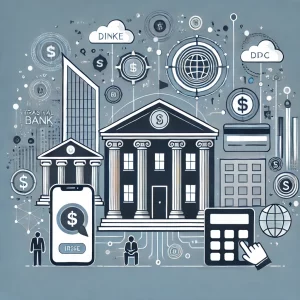How Blockchain is Disrupting the Financial Industry

Blockchain technology has emerged as one of the most transformative innovations of the 21st century, with the potential to reshape the financial industry in fundamental ways. Initially introduced as the underlying technology behind Bitcoin and other cryptocurrencies, blockchain has since evolved into a powerful tool with far-reaching applications beyond digital currencies. Today, it is disrupting traditional financial systems by offering enhanced security, transparency, and efficiency.
In this article, we will explore how blockchain is disrupting the financial industry, its key benefits, and the challenges it faces as it continues to gain traction.
What is Blockchain?
At its core, blockchain is a decentralized and distributed digital ledger that records transactions across multiple computers in a network. Each transaction is grouped into a block, which is then linked to the previous block, forming a chain. This structure ensures that once a transaction is recorded, it cannot be altered or deleted, providing a high level of transparency and security.
Key features of blockchain technology include:
- Decentralization: No single entity controls the blockchain, making it resistant to manipulation and centralized failure.
- Transparency: All participants in a blockchain network have access to the same data, ensuring transparency and accountability.
- Immutability: Once a block is added to the blockchain, it cannot be altered, reducing the risk of fraud or unauthorized changes.
- Security: Cryptographic algorithms ensure that data is securely stored and transferred, making blockchain highly secure.
How Blockchain is Disrupting the Financial Industry
1. Faster and Cheaper Transactions
One of the most significant impacts of blockchain in finance is the ability to process transactions faster and at a lower cost than traditional systems. In conventional banking systems, cross-border transactions can take days to settle and involve multiple intermediaries, each charging fees. Blockchain, on the other hand, allows for near-instantaneous transactions without the need for intermediaries.
For example, Ripple, a blockchain-based payment protocol, enables real-time cross-border payments with lower fees and faster settlement times compared to traditional banking methods. By removing intermediaries such as correspondent banks, blockchain can significantly reduce transaction costs, particularly for international transfers.
2. Enhanced Security and Fraud Prevention
Security is a top priority for the financial industry, and blockchain’s decentralized and encrypted nature makes it highly secure. In traditional financial systems, a single point of failure, such as a compromised bank or payment processor, can lead to fraud or data breaches. Blockchain eliminates this risk by distributing data across a network of nodes, making it nearly impossible for hackers to manipulate or alter transaction records.
Additionally, blockchain’s immutability ensures that once a transaction is recorded, it cannot be changed or tampered with. This feature is particularly valuable in preventing fraud and ensuring the integrity of financial transactions. For instance, blockchain can help verify the authenticity of documents, contracts, and identities, reducing the risk of fraudulent activities in financial services such as lending and insurance.
3. Improved Transparency and Accountability
Transparency is another area where blockchain is making a significant impact. In traditional financial systems, transactions and records are often controlled by a centralized entity, which can lead to a lack of visibility and accountability. Blockchain’s decentralized nature ensures that all participants in the network have access to the same information, providing full transparency into the movement of funds and assets.
This transparency is particularly beneficial for regulatory compliance, as it enables real-time auditing and monitoring of financial transactions. For example, central banks and regulatory authorities can use blockchain to track money laundering activities or monitor compliance with anti-money laundering (AML) and know-your-customer (KYC) regulations.
4. Smart Contracts and Automation
Blockchain’s capability to support smart contracts is another game-changer for the financial industry. A smart contract is a self-executing contract with the terms of the agreement directly written into code. Once the conditions of the contract are met, it automatically triggers the next steps in the process, such as transferring funds or issuing a payment.
Smart contracts have the potential to automate a wide range of financial services, including loan approvals, insurance claims processing, and securities trading. For example, in the insurance industry, smart contracts can automate claims processing by automatically verifying the conditions of the claim and issuing payouts without the need for human intervention. This reduces the time, cost, and complexity associated with manual processes, improving efficiency for both customers and service providers.
5. Disintermediation and Peer-to-Peer Transactions
Blockchain’s decentralized nature allows for direct peer-to-peer (P2P) transactions, removing the need for intermediaries such as banks, brokers, or payment processors. This disintermediation is particularly disruptive to traditional financial services, as it reduces the reliance on central authorities and creates new opportunities for individuals and businesses to interact directly.
In the realm of lending, for instance, blockchain-based platforms like Aave and Compound allow users to lend and borrow digital assets without the need for a traditional bank. This P2P lending model can offer better interest rates for both borrowers and lenders while reducing the overhead costs associated with traditional financial institutions.
Similarly, decentralized finance (DeFi) platforms are leveraging blockchain technology to offer a wide range of financial services, including savings, investments, and trading, all without the need for intermediaries. These platforms provide users with greater control over their assets and enable more efficient financial interactions.
6. Tokenization of Assets
Tokenization refers to the process of converting physical or digital assets into tokens on a blockchain. These tokens can represent ownership or rights to an asset, such as real estate, stocks, or commodities, and can be traded or exchanged on a blockchain network.
In the financial industry, tokenization has the potential to democratize access to assets by allowing fractional ownership. For example, investors can buy and sell fractions of a real estate property or artwork, making these assets more accessible to a wider range of investors. Additionally, tokenization increases the liquidity of traditionally illiquid assets, as tokens can be easily traded on blockchain-based exchanges.
Security token offerings (STOs) are an emerging trend that allows companies to raise capital by issuing tokenized securities on a blockchain. This provides a more efficient and transparent alternative to traditional initial public offerings (IPOs) and private placements.
Challenges and Opportunities
While blockchain technology offers numerous benefits to the financial industry, it also faces several challenges:
1. Regulatory Uncertainty
One of the biggest hurdles to widespread blockchain adoption in finance is regulatory uncertainty. Different countries have varying approaches to regulating blockchain and cryptocurrencies, which can create confusion for businesses and investors. Clear and consistent regulations are needed to foster innovation while ensuring compliance with existing financial laws.
2. Scalability Issues
As blockchain networks grow, scalability becomes a concern. Traditional blockchains, such as Bitcoin and Ethereum, have faced challenges in processing a large number of transactions efficiently. Solutions such as layer-2 protocols and sharding are being developed to address these scalability issues, but widespread adoption will take time.
3. Integration with Legacy Systems
Many financial institutions rely on legacy systems that are not compatible with blockchain technology. Integrating blockchain into these systems can be costly and time-consuming. However, as blockchain technology matures and more financial institutions adopt it, we can expect smoother integration and more streamlined processes.
Conclusion
Blockchain technology is revolutionizing the financial industry by enabling faster transactions, enhancing security, improving transparency, and offering new ways to conduct financial services. As the technology continues to mature, it is likely to disrupt traditional financial systems further, creating new opportunities for businesses and consumers alike. While challenges such as regulatory uncertainty and scalability remain, the potential of blockchain to transform finance is undeniable. As more institutions embrace blockchain, we are entering an era of greater efficiency, security, and innovation in the financial sector.




